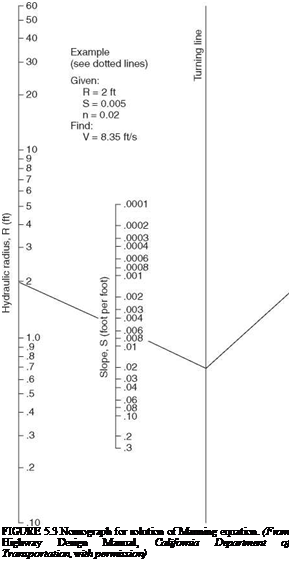Energy Equation
The energy equation is based on the principle that energy must be conserved; that is, the energy at any one cross-section on a stream is equivalent to the energy at any other section plus any intervening energy losses. This relationship, a form of the Bernoulli equation, may be used wherever there is a change in the size, shape, or slope of the channel and is useful in determining the depth of flow.
 |
 |
/ V2 І V2
z1 + d1 + у j = z2 + d2 + у ^Lg j + hL (5.13)
where zn = distance above some datum, ft (m) dn = depth of flow, ft (m)
Vn = flow velocity, ft/s (m/s) g = acceleration of gravity, 32.2 ft/s2 (9.8 m/s2) hL = head loss between the two sections, ft (m)
|
TABLE 5.6 Values of the Roughness Coefficient n for Use in the Manning’s Equation
2004, with permission. |
Subscripts 1 and 2 refer to two sections along the flow line as depicted in Fig. 5.4. The velocity head is given by V2/2g and the specific energy is defined as d + V2/2g. The plots in Fig. 5.4 illustrate the head at points along the length of the channel. The line drawn through points of static head is known as the hydraulic grade line, and the line drawn through points of total head is known as the energy grade line. The head loss between sections includes losses due to flow friction along the channel and losses due to turbulence at junctions and bends.






Leave a reply